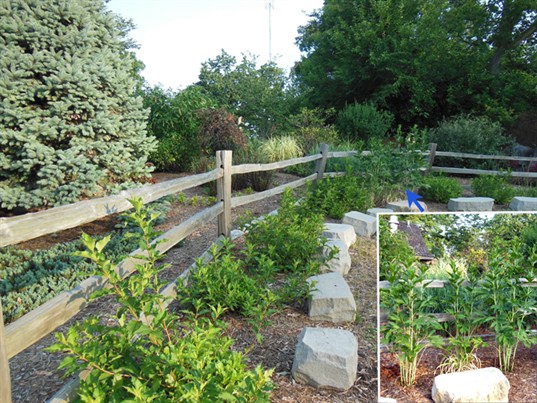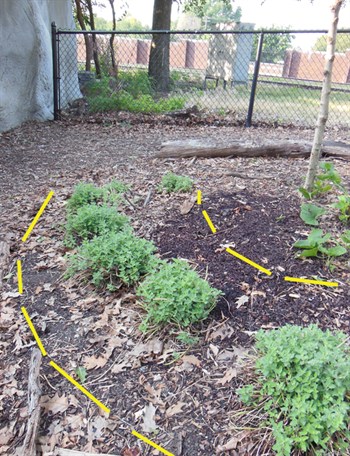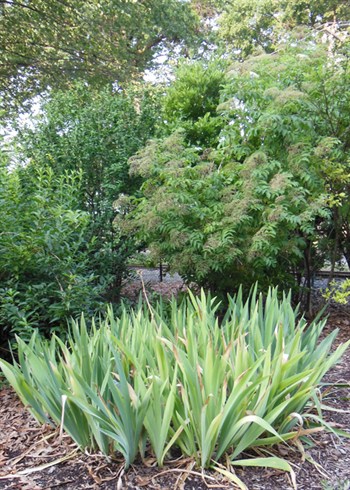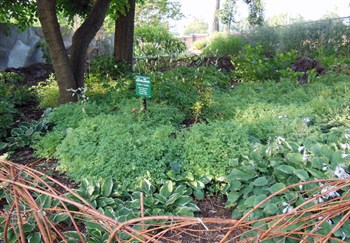When tough weather lingers in summer, it can be discouraging.
The plants look so worn! In addition, the simple advance of
the growing season means plants have filled out their space.
The flower-to-leaf ratio drops. There's more green, less
flower.
This article Sponsored by:
If these conditions prevail in the garden and your mind today,
take the most productive tack:
Focus on what looks good rather than the other way around.
That was our perspective as we decided what to do in our Detroit
Zoo Adopt-A-Garden, one morning in July. Record setting heat and
drought had taken their toll, and compounded the damage inflicted
when a too-early spring coaxed plants to precocious growth that was
then zapped by frost.
Yet when we were done in just two hours, 12 people had tweaked
and watered 5,000 square feet so what had been a bit tired
looking, was gorgeous. That's 400 square feet per person, a lot of
ground to cover but do-able if you're smiling rather than glum.

Right: An arc of Weigela looking wonderful. These
plants not only held up under tough conditions but had the gumption
to rebound from their annual hard cut-back -- four weeks ago as
their first bloom ended we cut all the four-foot tall blooming
stems to the ground. So most of the foliage on these plants is
brand new, grown out clean and full despite weeks without rain and
days at a stretch with temperatures above 90 F. At the center of
the line, giant coneflowers (Rudbeckia maxima) stand tall
and unruffled. However, that's seems only right for a prairie
native.

Right: This bed features winners from our last drought-time
survey. Two years ago we dubbed them winners, divided and
transplanted them here all in a day, even as that drought
prevailed. They never faltered. In the foreground, flower stems
from sea lavender (Limonium latifolium) beg clipping, and
orange Helen's flower (Helenium autumnale) wants
deadheading, too. But zebra iris (I. pallida
'Argenteo-variegata'), threadleaf bluestar (Amsonia
hubrichtii) and peony look so fresh it takes the edge off. Also
in this full sun bed, from our list below: Curly chives, northern
sea oats, cooking sage and blue mist spirea.
Before introducing our stars...
...you should know what conditions prevail that they rise
above.
- The garden has no irrigation system (we try to hand water
annuals once per week).
- The soil is excessively drained sandy loam and it's alkaline:
Depending where you are in the 1/8 acre area, the pH is 7.4 to
7.8.
- Sunlight:
- Some beds are in full sun (plants there cast a sharp shadow for
more than 6 hours per day),
- Others are in part shade (between 4- and 6 hours' sun each day)
and
- A few beds are in shade (less than 4 hours' sun).
- Some beds in sun are unfortunately populated with shade lovers.
We've recently lost many trees to emerald ash borer and lingering
construction damage, and haven't changed everything over, yet.
This year is the second worst I've
ever seen, almost as bad as the devastating drought of 1988. A tree
that looked great despite everything in '88 and is repeating that
performance this year is Maackia amurensis (Amur maackia).
- Professor Emeritus Ed Hasselkus,
University of Wisconsin, Madison -
Plants that sneer at heat and drought
Bearded irises (Iris germanica) have positively
flourished in this weather.
Blue bush clematis (Clematis heracleifolia) is looking
good. (Right.) We can depend on its small, light blue,
fragrant flowers to make us smile in August. (You'll have to tune
back in to see the flowers. What we care about today is its
upstanding form and foliage!)
Blue mist spirea (Caryopteris x clandonensis, photo) is one tough cookie. Its blue
flowers help cool the scene in late July. The heat may also have
increased the fragrance of its sweetly scented foliage.
Bronze fennel (Foeniculum vulgare 'Purpureum') is
straight, tall, smelling of licorice and abuzz with honey bees and
beneficial insects.
Butterfly bush (Buddleia davidii) seems to say, "Bring
it on, do your worst." Its flowers may be opening and finishing
more quickly than usual as a result of the heat. Or maybe it's not
the heat. Since so many other nectar sources have failed,
pollinators are practically standing by for each bloom to open.
Being pollinated immediately means each flower finishes more
quickly.
Catmint (Nepeta x mussinii, photo) We take the lazy way after its first
bloom and just cut it to the ground. Since we did that, there's
been no rain and we never water this bed. Yet the plants are
respectable clumps once again.
Celosia, an annual we have in greater number than usual because
the rabbits leave them alone. So does the heat. (Note: We
do water the annual flowers about once a week.)
Creeping St.
Johnswort (Hypericum calycinum, right, foreground) It's
been one of the surprise stars in our shady dry bed, its
presence there all the result of a whim, "What the heck, we have
extra of this, let's see how it does in that space nothing else
seems to like." This species is never loaded with flowers in our
climate and sometimes bears only two or three, yet it's still worth
having for its fresh greenery and dense semi-evergreen service as a
groundcover.
Curly chives (Allium senescens glauca, photo) is a July blooming beauty. Its
blue green foliage has a sinuous twist and is always
immaculate.
Dwarf hybrid goldenrod (Solidago sphacelata 'Golden
Fleece', photo). Stalks are
developing now to hold its late summer bloom high above the leaves.
Neither flower stems nor foliage look at all perturbed by the tough
weather they've seen.
Fig tree (Ficus carica, photo) seems
to think it's on holiday back home on a dry, hot Mediterranean
hillside. (It's not hardy through our winters so we bury it each
fall to keep it alive.)
Golden bleeding heart (Corydalis lutea, photo) The plants stopped blooming, which is a
shame since they usually carry the shade garden through July. But
otherwise the plants are their usual cheerful selves.
Grasses, especially some North American natives: switch grass
(Panicum virgatum, photo) from the
prairie and northern sea oats (Chasmanthium latifolium)
from the Atlantic dunes.
Ironweed (Vernonia glauca) is standing tall, soon to
grace us with purple flowers and attendant butterflies.
Juniper. Such a shame that so many plant people shrug them off,
"Oh, just a juniper."
Lambs ear (Stachys lanata, photo) looks wonderful, in large part
because it was cut back on schedule. We did that two weeks ago,
razing all its 18" flowering stems as it finished bloom.
Large flowered comfrey (Symphytum grandiflorum, photo) We often wonder why this plant isn't used
more. Perhaps people confuse it with its tall, rank, seed-dropping
cousin? Its pale yellow spring flowers are not show stoppers but
talk about a sturdy, weed-stopping groundcover for sun or part
shade!
Lavender (our Lavandula angustifolia variety is a
long-stalked heirloom but we've forgotten its name!) This is
another Mediterranean native loving the back-home weather. Photo.
Perilla (P. frutescens) A purple leaf, anise-scented,
self sowing annual so prolific that some people list it as a weed.
We thin the volunteer seedlings in spring, leaving some in
strategic places to cover for fading bulbs or ephemeral perennials.
Other than thinning, we do not fuss over them. They simply
grow.
Pinks (Dianthus gratianopolitanus) has a reputation for
being short lived but that's not been our experience. Some of our
clumps of 'Bath's Pink' are 15 years old. Perhaps dry soil is
conducive to long life for this species. At right, four
performers: A) Dianthus, B) lavender, C) butterfly bush and D)
horseradish
Plumbago (Ceratostigma plumbaginoides) has not lost a
beat to the heat. It's now beginning to bloom, about four weeks
early. That's another consequence of the early spring. Photo.
Pokeweed (Phytolacca americana) This native North
American "weed" is enjoyed by many for its stature (8' tall and
wide is not unusual). It's also planted or tolerated for it
attractive, bird-loved berries in late summer. European gardeners
are specially fond of this species North Americans disdain, and so
it's available in catalogs.
Purple bush clover (Lespedeza thunbergii) Full and
right on schedule. It'll be our blooming star in September. Other
than its usual trouble with potato leafhoppers, which produce the
pale margins and eventual scorch known as hopper burn.
At right: An arrow marks the bush clover, growing alongside
the equally stalwart white-barked seven son shrub (Heptacodium
miconioides).
Red elder (Sambucus pubens) is a stand up guy. Its
berries have all gone to the birds, who like them in any year but
flock to them when rains fail. This red elder at right has "extra
mulch" at its feet --- the dried remains of sweet woodruff
(Galium odoratum) that could not tale the drought and
heat.
Rose of sharon (Hibiscus syriacus, photo) is fully cloaked in clean greenery and
starting to bloom -- ahead of schedule, another product of the very
early spring warm-up. It's putting to shame the dogwoods and
hydrangeas in its vicinity.
Sage (Salvia officinalis) We should be clipping it and
drying the new leaves that have grown since it finished bloom. They
are almost certainly top notch in terms of flavor since the leaves
create the flavorful oils as protection from heat and sun.
Sea kale's big blue leaves (Crambe maritima, photos) are a cool sight in hot weather, and
its big cousin the giant crambe (C. cordifolia, photo) is also looking good
(thanks to a deadheading two weeks ago).
Sea lavender (Limonium latifolium) Too bad its flower
stalks toppled because otherwise the flowers dry in place and are
attractive for more than a month.
Sedum 'Meteor' and other tall varieties of S.
spectabile
Siebold viburnum (V.
sieboldii, below, left) It's naturalized and become invasive
in some parts of the country. We haven't seen that in Michigan but
we can see it certainly can get by on its own.
Below, left: Siebold viburnum. Right: Ural false spirea and
plumbago.


Spruce, Colorado blue
Tall coneflower (Rudbeckia maxima), a tallgrass prairie
native.
Threadleaf bluestar (Amsonia hubrichtii, photo), spring blooming, it's grown right up over
its seed pods now and will maintain its neat appearance until it
blazes gold in late fall.
Ural false spirea (Sorbaria sorbifolia, above, right with
plumbago) is a totally dependable, full blooming thug. The
only consequence of drought and extreme heat seems to be blossoms
that age and finish faster than usual. No matter -- we'll deadhead
those branches and more flowers will come.
Weigela florida. Sustained themselves in tough
conditions and simultaneously rebounded from our standard hard
cut-back, four weeks ago at the end of their primary bloom
season.
Below: It was on the basis of leaf
size that we paired blue mist spireas (Caryopteris x
clandonensis, background) with giant crambe (C.
cordifolia, foreground, producing newleaves after having been
cut-back after its bloom two weeks ago). The coarse crambe and fine
Caryopteris are a visually pleasing pair, so it's even better than
they both fare well in dry heat. Between the two they keep this bed
looking good.

Below, left: Despite the
drought, the catmints are growing back nicely after a hard
cut-back. The plants were sprawled and covered a much larger area
after their spring bloom -- outlined yellow. Now the plants are
neat and on track to bloom again in a week or two.
Below,
right: Curly chives (A), lambs ear (B) and late goldenrod (C).


Below, left: The fig tree seems
to be enjoying this hot, dry summer, and is certainly ripening
plenty of fruit.
Below, right: A blue-leaf form of switch grass (Panicum
virgatum)


Below, left: Large flowered
comfrey (Symphytum grandiflorum) is a tough, easy care groundcover
that should be used more.
Below, right:Bearded iris, in front of elderberry.


Below, left: Threadleaf
amsonia.
Below, right: Rose of sharon,
leafy and happy. Other shrubs in the area, such as the panicle
hydrangea on the left, are barely visible because they have so few
leaves.


Below, left: Golden bleeding
heart isn't looking gold since it stopped blooming early.Yet its
fine blue green foliage and mounded form continue to make the dry
shade garden look full. (We'd have listed our hostas 'Blue Cadet'
as stars but their foliage had scorched edges. None of us could
recall if that scorch dated from this year's unusual spring and
frosts, or was more recent!)
Below, right: Even the
just-rooted lavender cuttings are looking wonderful. We stuck the
cuttings last November, snugging them up against this curb so they
would have a bit of shade in the afternoon.


Below, left: Sea kale,
what a trooper. In spring this big foliage was pleasing, and
subtended the bloom of Camassia 'Blue Danube.' Then
the plants bloomed white and fragrant and as they finished we cut
them back to the ground. As it produced this second set of big
leaves, blue California hyacinth bulbs (Tritelia laxa)
bloomed around and through it.
Below, right:
Bronze fennel (Foeniculum vulgare 'Purpureum') looks good
right now with the large blue leaves of sea kale but its role is
even more important at the end of summer. Then it will play the
"smoke" to the "flame" of red salvia in what we call our campfire
garden. So we're very glad it's held up well. As the days shorten
and the red salvia come into their own that bed will be
cookin.'


Sponsored by:

To browse other
Sponsor-recommended articles, click here or on any Sponsor
seal to reach those lists. From our Sponsor lists you can jump
directly to articles from the names of the people who endorsed
them, or choose by topic.